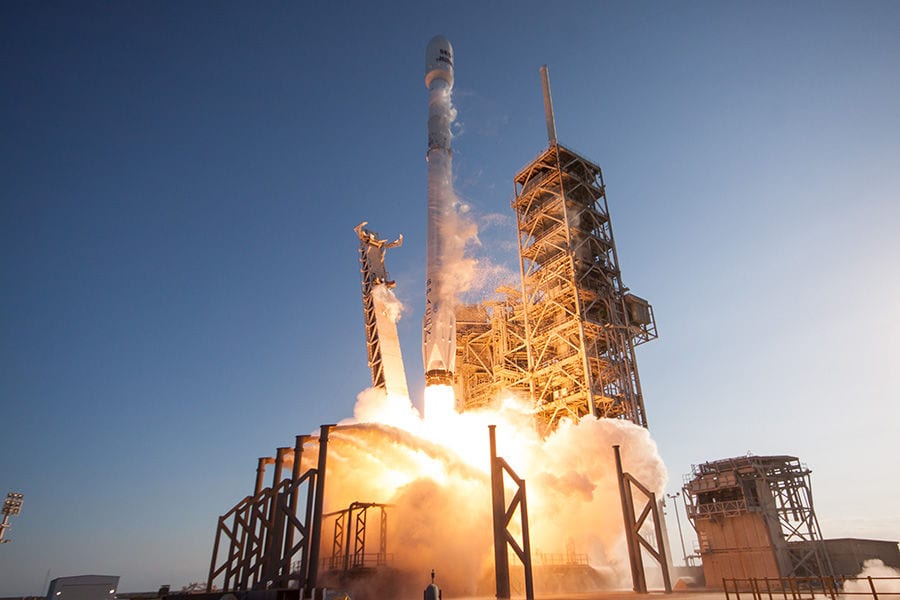
A SpaceX rocket launch. Photo courtesy of SpaceX
A panel of aviation industry members agreed that, because the technology is new, integrating commercial space operations into the U.S. National Airspace System (NAS) will require concessions — for now.
“You wouldn’t want regulations on the Wright brothers,” said Aerospace Industry Association (AIA) VP Frank Slazer during the Air Traffic Controller Association and FAA’s Commercial Space NAS Integration Conference in Washington, D.C. this week. “But that can’t continue forever.”
With more and more companies interested in commercial space operations, the government and industry are grappling with the prospect integrating those operations into an airspace which hinges on careful timing and management of flights — a challenge that also faces unmanned operations. Because rocket launches are fickle and sometimes get canceled, closing down airspace means issuing a six-hour temporary flight restriction (TFR) notice to airmen (NOTAM) for one launch that may or may not happen.
According to Slazer, that works right now because it will be a long time before launches are common enough or spread out enough that they truly hamper other operations. Even with companies like SpaceX and Blue Origin that are years into operation, there aren’t a lot of commercial launches each year, and the vast majority happen in a few specific, fairly remote locations, such as Cape Canaveral, Florida.
“We have time to do this right, and we have time to look at what we did in aviation in terms of developing standards,” Slazer said, pointing out that the first jet engine was developed two decades before it was commonly used in the Boeing 707.
Melissa Rudinger is the VP of government affairs for the Aircraft Owners and Pilots Association (AOPA), which represents a swathe of general aviation pilots with various aircraft. She said the dynamic management of airspace to avoid closing it down for hours at a time is a big issue for pilots.
“Right now, we’re accommodating commercial space launches — and I think that’s appropriate, as a new technology, just like UAS — but the goal should be to change that in the next decade or so,” she said. “I don’t think we should look at commercial space any differently than we look at any other commercial entity, including UAS — they’re just another user.”
The panel agreed that as the NextGen era nominally winds down, the FAA’s efforts in the NAS need to evolve to match the pace of technology.
“NextGen is ill-defined. Ask anybody in our industry and you’ll get different answers [about what it is],” said Paul McGraw, VP of operations and safety for Airlines for America. “We don’t need monikers for the next step in evolution for our airspace.”
There was less consensus, however, on how to handle tracking aircraft within the NAS. Rudinger said there can’t be a one-size-fits-all solution.
“When we hear folks talk about a single solution like, ‘Everybody, just equip with ADS-B and done,’ it will never work,” she said, pointing out that some members of her organizations fly with no electrical system. She said while about 85% have a transponder, whether visual flight rules (VFR) or instrument flight rules (IFR), some subset will never have one. She also said it’s important that VFR flights continue regardless of transponders.
“It would be crushing to the air system if we required everyone to fly IFR,” she said. “I think the system would be overloaded in a heartbeat.”
A presence or lack of connectivity by pilots can matter because it might determine how looped in pilots are to near-real-time updates on TFR statuses. Right now, airspace is shut down for six-hour blocks, but as commercial space operations are farther integrated into the NAS, flights need to be allowed through the airspace up until sooner before and after the launch to keep things running smoothly, the panel said. That can be facilitated by things like a third-party application on a tablet.
But, to allow flights to go right up until a launch, controllers need to be confident when a launch is going to happen.
“Certainly, there is a need of something more dynamic than TFRs,” Slazer said. “They’re a blunt instrument, but they’re a blunt instrument for a reason. And they’re not particularly temporary. To be more precise, you need to be more reliable.”